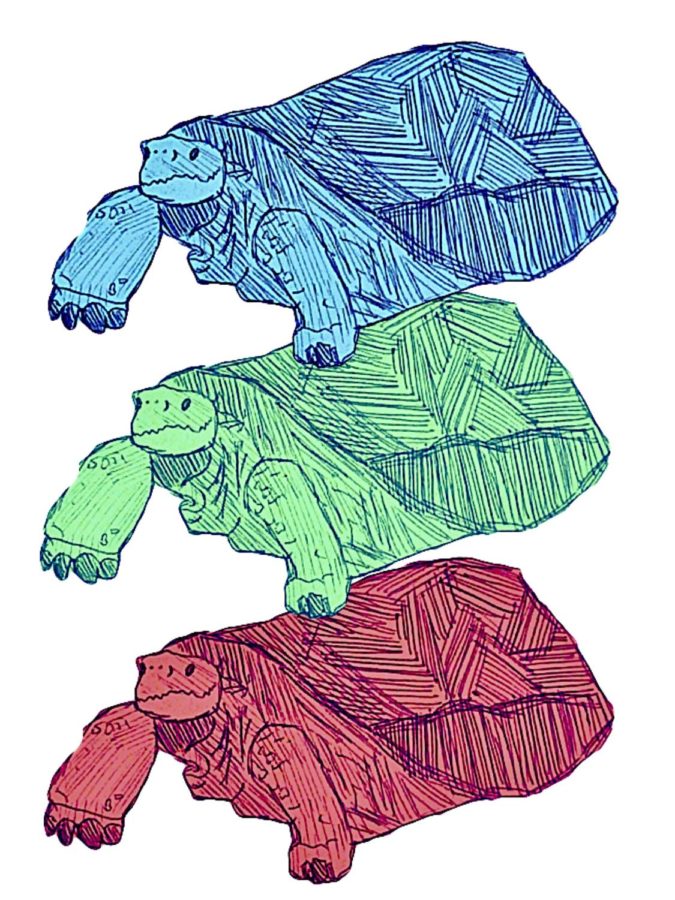Opinion | It’s dangerous to let tortoises roam courtyards during lunch
This year, many students have opted to eat lunch in ETHS’ beautiful Planetarium Courtyard. The courtyard is home not only to hungry students, but to some of ETHS’ most well known inhabitants—Tudi and Mulan, the migratory tortoises. However, despite this duo’s popularity, letting tortoises and humans share a space during lunch periods poses many dangers for the hard-shelled reptiles.
Many students in the courtyard feed the tortoises food from their lunches, which, while well intentioned, could be unhealthy for Tudi and Mulan. Human food sometimes contains acids and other substances that could make the turtles sick. According to Exotic Direct, citrus fruits such as oranges and lemons are known to cause health problems for tortoises, as well as citrus flavored snacks or drinks. Avocados, a popular item in student’s sandwiches, are also very unhealthy for the tortoises. Thus, continuing to allow students to feed the tortoises could unintentionally cause digestive and general health problems.
“The number one health hazard for tortoises, and a lot of reptiles, are what are considered cruciferous vegetables. Not dark leafy greens, but things like broccoli, and things related to broccoli, believe it or not, are cruciferous vegetables,” says Scott Meier, one of the caretakers of the tortoises.
Cruciferous vegetables are rich in vitamins and minerals, like folate and vitamin K. While this is very beneficial to humans, it can be detrimental to tortoises who are used to foods low in vitamins.
“The reason why, in large quantities, that’s potentially hazardous is because of the amount of calcium and phosphorus that those vegetables have in them and what it does to the tortoises ability to metabolize calcium, so the calcium doesn’t go where it’s supposed to go,” Meier continues.
In small amounts, this doesn’t pose a huge issue. However, if tortoises continue to be fed cruciferous vegetables long term, it could cause their metabolism to slow and make it much harder for them to process calcium.
One way to prevent students from giving tortoises human food is educating those who interact with Mulan and Tudi. Most students are well intentioned when they interact with the animals, so explaining the ways in which certain actions are unsafe will surely be effective. Whether this is in the form of signs or announcements, it’d be a great way to help solve this problem. Another potential approach could be creating a rule that bans students from giving their food to the tortoises. While a rule would be less effective than an educational angle,—students are much more likely to break rules—it’d still help everyone understand the dangers of feeding the tortoises.
“I think some sort of announcement would help, because it brings what’s happening [to the attention] of the whole school.” Ethan Lloyd, a freshman who eats in the courtyard, says. An announcement about the tortoises would definitely help raise awareness about the situation and minimize the dangers tortoises may face. Students who feed the tortoises for their own entertainment most likely have no idea of the long-term consequences, such as calcium overload.
“One of the biggest concerns quite honestly is [the tortoises] having kind of a nutrient overload. And that’s actually evident in both of their shells,” Meier states, alluding to the fact that the tortoises are already showing signs of illness from the amount of foreign food they consume. Students who feed the tortoises are largely contributing to this issue.
People who eat in the courtyard are also prone to leaving trash all around the area, which tortoises may try to eat. Chip bags, soda cans, and ziplocs are indigestible for the tortoises, and could block their digestive tract, causing them to starve.
“I’ve definitely seen wrappers on the floor, and, in my opinion, that could be harmful for the tortoises if they eat one,” explains Lloyd.
According to Consumer Reports, plastic is also capable of breaking down into microplastics: microscopic particles that can cause dangerous inflammation when ingested. Sharp cans are capable of cutting the tortoises internally and externally. Ziploc and chip bags are a suffocation hazard, as well as indigestible. Until students stop littering in the courtyard, tortoises should be kept away from them during lunch blocks.
“I see people touching them quite often, and it worries me, because I feel like the tortoises aren’t getting any space.” Lloyd expresses his worries about the tortoises being harassed, which is another unfortunately common occurrence.
During lunch periods, students often try to provoke the tortoises. People have been stepping on them, poking them and even yelling at them. There seems to be a lack of understanding that the tortoises are living beings and shouldn’t be pushed around to that extent. Since the tortoises live at ETHS, human contact isn’t rare for them, but that’s not an excuse to purposefully harass them. In late September, a student was caught on video picking up a tortoise. This behavior is unacceptable and will not stop until students stop encouraging it. Even when students aren’t touching the tortoises, they tend to crowd them. Just like other animals, the tortoises need their space.
“This is a new experience for us because students, up until this year, have not been permitted in the courtyard,” Meier explains.
Before this year, the tortoises weren’t exposed to humans nearly as often, meaning Tudi and Mulan aren’t used to this amount of interaction and foreign foods. Courtyard littering, feeding and harassment of the tortoises all pose their own individual dangers to the reptiles. Irresponsible student behaviors have contributed to an unfortunately high-risk environment, and it isn’t getting any better. Until signage or rules are established that prevent students from littering, harassing and feeding the tortoises, they should be kept inside during lunch periods.
Your donation will support the student journalists of the Evanstonian. We are planning a big trip to the Journalism Educators Association conference in Philadelphia in November 2023, and any support will go towards making that trip a reality. Contributions will appear as a charge from SNOSite. Donations are NOT tax-deductible.














Vivien Bissell • Oct 18, 2021 at 1:43 pm
I had no idea the tortoises were being harrassed this badly. That is so awful and sad. I eat in the courtyard and have unfortunately witnessed some of this behavior. It makes me sad and angry how people seem to not care about them at all. I wonder if Tudi and Mulan would benefit from being moved inside again, as I feel that unfortunately, some students will ignore rules and still mess with them. It’s a shame that we have such amazing animals at this school and people take them for granted and trash their homes and hurt them. 🙁 Thank you for this article. This is so important.